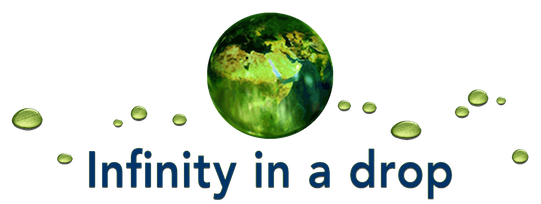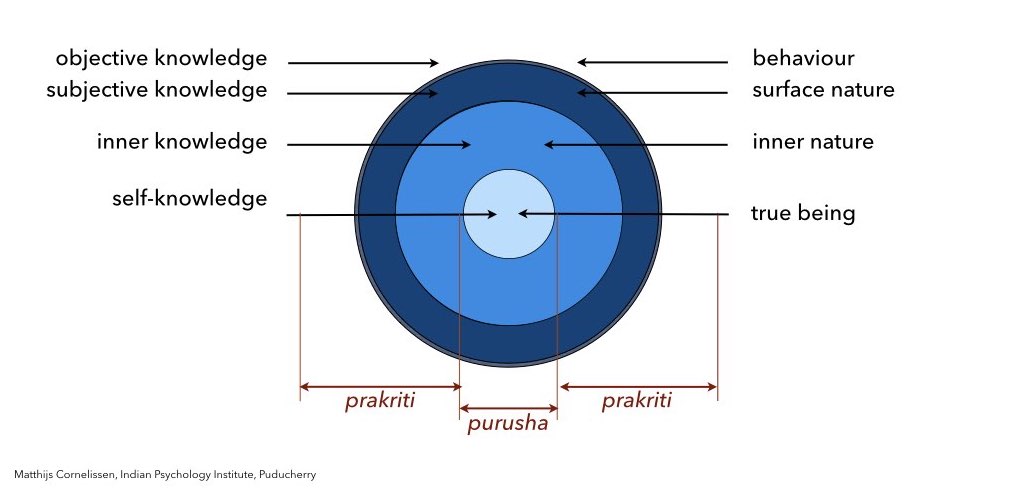
The Self and the structure of the personality
An overview of Sri Aurobindo's terminology
Matthijs Cornelissen
last revision: 14 October 2023
section 2
the concentric system
This is the second in a series of eight sections.
If you haven't read Section 1, you may like to read that sections first:
The concentric system is what one encounters when one ventures inward from the surface nature in the direction of one’s innermost self. In the concentric system, Sri Aurobindo distinguishes three major realms: an outer nature and an inner nature — both part of prakṛti, universal Nature — and a true nature, which belongs to the puruṣa, the Self. (LY-1, pp. 84-85)
Outer nature is the term Sri Aurobindo uses for that part of being that a person is conscious of, at least to some extent, in the ordinary waking state of his or her normal everyday life. In this outer nature, physical, emotional, cognitive, and conative elements are all mixed-up together. When people get angry, for instance, their body and mind tend to be as much involved as their feelings; on the surface, thoughts are rarely entirely free from emotional coloring; bodily states — like tiredness and freshness, illness and health — affect the way an individual feels and thinks; the mind affects the way one feels both emotionally and physically.
The longer one studies oneself, the clearer it becomes that this outer nature is only a tiny part of one's existence as a whole. Freud considered (1900/2010) that:
The unconscious is the true psychical reality; in its innermost nature it is as much unknown to us as the reality of the external world, and it is as incompletely presented by the data of consciousness as is the external world by the communications of our sense organs. (p. 607)
Sri Aurobindo said more or less the same when he remarked:
We are not only what we know of ourselves but an immense more which we do not know; our momentary personality is only a bubble on the ocean of our existence". (LD, p. 576)
The situation gets more complicated because the outer nature is the end result of the “immense more” mentioned above, of which most of us are not at all aware. The main purpose behind the complex concepts and maps used in this chapter is to make it easier to find one's way through these semi-conscious inner realms and to see more clearly from where feelings, thoughts and actions arise. We will discuss how this can help if we want to change our nature in the chapter on self-development.
Inner nature is the term Sri Aurobindo uses for that part of the being which is not fully accessible to an individual in his or her ordinary waking consciousness. The word inner might give the impression that one is dealing only with a small, dark, and purely private territory. According to Sri Aurobindo, the opposite is true: The inner nature (a) is vaster and more luminous than the outer nature; (b) has access to broader and higher ranges of experience and knowledge; and (c) is more, not less, connected to others and the rest of the world (LD, pp. 442, 554–564).
It may be good to realise that people who have not developed a sufficiently deep awareness of their inner states and processes will tend to call only their immediately visible behaviour their "outer nature", and they will call whatever else they know of themselves, their "inner being". Because Sri Aurobindo's reference point is much further inside, he calls the little that most people know of themselves the outer nature (e.g., Sri Aurobindo, LY–I, pp. 84-85), and he includes only that part of human nature that most people are not aware of at all in their inner being. For a more detailed discussion of what different people and cultures call outer and inner, please see in the next section of this chapter which deals with the centre and borders of the Self .
Partial glimpses of the inner nature can be experienced through dreams. Dreams are, however, not really the "royal road" that Freud held them to be (2010, p. 604). They are more like incidental cracks in the wall that separates the inner from the outer nature. To explore the inner nature systematically, an expert level of inner observation and training is required that, as has been discussed in the introduction, involves a relocation of one’s center of perception inwards. We'll have a closer look at those methods in the chapters on knowledge.
Though Sri Aurobindo sometimes uses the word subconscious to describe this hidden part of the human nature, he prefers the term subliminal1 as it does not imply that it is smaller or less conscious than the outer nature.
The sublimenal is that part of a person that is below the threshold of one’s ordinary outer awareness. Most people are not aware of what the subliminal contributes to their lives except indirectly through unexplained feelings and changes of mood, through dreams and other special states, or through sudden thoughts and flashes of insight, which the subliminal throws up onto the surface. According to Sri Aurobindo all these contributions from the subliminal are possible because the person, in the subliminal, is connected vertically to layers above and below his or her ordinary awareness and horizontally to other people and to the myriad of subtle forces and beings that surround the person (LD, p. 580, p. 605, p. 681, pp. 761–763).
Intraconscient is the term Sri Aurobindo uses for that part of the subliminal that deals with an individual’s own deeper and higher being. It is through the intraconscient that a person can become aware of those aspects in his or her own nature which one has no access to in one’s ordinary waking state. The intraconscient includes the area that Freud calls the unconscious, but the intraconscient also includes ranges above the ordinary waking consciousness that Freud ignored but Jung explored at least to some extent (Coward, 1985).
The circumconscient is the part of the inner being that connects an individual to others and to the play of cosmic forces[FN]. It is through this part of our nature that Sri Aurobindo sees most parapsychological perceptions taking place (LD, pp. 556–557).
True being and central being are two terms Sri Aurobindo uses for what one can experience as a kind of vertical axis at the core of one’s individualized existence:
The true being may be realised in one or both of two aspects — the Self or Atman [above] and the soul or antaratman, psychic being or caitya puruṣa [within] (LY-1, p. 97).
While the outer and inner natures belong to prakṛti, one’s true being is the puruṣa. Above all planes and worlds, it is the jīvātman who eternally and immutably presides over the manifest nature. The jīvātman is one’s highest individualized essence. Still further above it is the ātman, or paramātman, one’s true universal essence. Both can be experienced as the true Self — far above the ordinary earthly existence, transcendent, immutable, and eternal, if not beyond time.
Deep within one’s embodied being, behind the heart is the soul, the psychic entity, which represents the jīvātman in its incarnate existence (LY-1, p. 56 onwards). I will discuss these and other aspects of the Self and soul in more detail in a later section on the various centres of identity.

Figure 1-2-1a. The concentric system
A simplified diagram of the concentric system could then look like Figure 1-2-1a. It has on the right the names of the different parts of the nature, and on the left the types of knowledge that give access to them. See Chapter 6 for more details on these four types of knowledge. Appendix 1.2.1 gives some more info on how defective assumptions and methods of enquiry have limited what mainstream psychology can see.
Endnote
1Latin sub, below + Latin limen, threshold.
To receive info on
Indian Psychology and the IPI website,
please enter your name, email, etc.